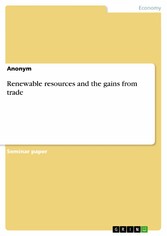Search and Find
Service
Renewable resources and the gains from trade
Seminar paper from the year 2018 in the subject Economics - International Economic Relations, grade: 3, University of Lüneburg, language: English, abstract: Expansion and liberalization of world trade lasted for ages at the expense of the natural environment. In 2013, the financial volume of world trade amounted to 23.4 trillion US $, about a third of world GDP. At the same time, global environmental indicators show the impact of trade on the environment. Population growth and rising incomes fuel the demand for goods and services, which is often met by natural resources, especially land and water. Tripling of the world population over the last six decades and fourfold the increase in GDP expected by 2050, were only some of the factors affecting on the growth of trade. These trends led to an increasing number of ecosystems in the world far beyond their service potential. For example, global demand for food is expected to double between today and 2050 year. By this time, it is estimated that 3.9 billion people or 40% of the projected world population will live in countries that are availability of just 1,000 liters of water per person per year. To reverse these trends, trade should be used as a catalyst for positive economic, social and ecological change, and not as a factor of environmental degradation. Some of the natural resources fulfill the role of living conditions of people. This also includes resources for recreation, treatment, and training. The rest serve the needs of industry. There are such a types of natural resources: By type of use. By the nature of the natural components. If possible, recovery. Inexhaustible types of natural resources are: water, cosmic,climatic. Natural resources are classified into practically inexhaustible and exhaustible. The latter are divided into renewable and non-renewable. The dividing line is conditional. Practically inexhaustible are the resources whose existence is not limited by time frames. At any intensity of their consumption, the quantity at the disposal of mankind does not decrease or decrease so insignificantly that in practice this magnitude can be neglected. Such resources include solar radiation, hydro- and wind energy potential, etc.
All prices incl. VAT












